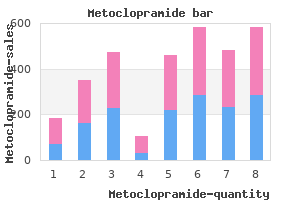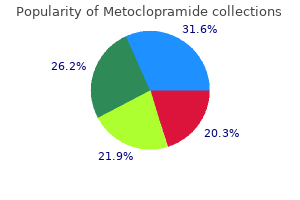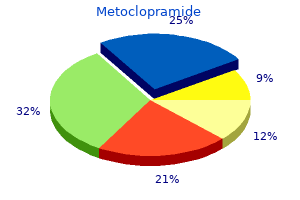CLINICAL,FORENSIC,AND ETHICS CONSULTATION IN MENTAL HEALTH
Metoclopramide
"Order metoclopramide master card, gastritis diet 50".
By: K. Murak, M.B. B.A.O., M.B.B.Ch., Ph.D.
Clinical Director, University of Virginia School of Medicine
Although nearly all body tissues are uncovered to circulating hormones gastritis diet алиэкспресс buy 10 mg metoclopramide free shipping, speciic hormones elicit a response only from sure cells and tissues gastritis diet nhs generic metoclopramide 10 mg amex. The capacity of a cell to reply to gastritis diet options 10mg metoclopramide with visa a selected hormone is dependent upon the presence of speciic receptors for that hormone on or in the cell chronic gastritis shortness of breath discount metoclopramide 10 mg. Target cells are in a position to regulate their responsiveness to hormones by altering the receptor number, afinity, and eficiency of coupling to intracellular responses. Speciicity refers to the molecular "it" of a hormone within a receptor-binding pocket. Afinity describes the diploma of "tightness" of the hormone-receptor bond, or the inclination of the hormone to remain bound to the receptor. Speciicity and afinity determine whether or not a cell with a receptor will respond to a hormonal stimulus and the hormone concentration at which the receptor effectively can bind the hormone. The potency of the hormone, or the amount of hormone required to elicit a mobile response, depends partially on the afinity of the receptor for a particular hormone. The greater the afinity of the receptor for a hormone, the lesser the quantity of hormone needed to produce a response. For example, prolactin and development hormone both can bind to the prolactin receptor, but with differing afinities. However, in the condition called acromegaly, during which extreme concentrations of growth hormone result in large bone and tissue overgrowth, milk may be secreted from the mammary glands secondary to progress hormone stimulation of prolactin receptors. The set level is genetically determined and inluenced by age, gender, circadian cycles, and present inner and environmental situations. These feedback techniques are detailed for the hormones of the pituitary system in later sections of this chapter. Knowledge of feedback controls is helpful when evaluating sufferers for endocrine diseases (see Chapter 40). Up-regulation, or an increase within the number of receptors in response to chronically low hormone concentrations, may also occur. Up-regulation would make the cell extra sensitive to the hormone, and hormone-dependent mobile exercise could happen at normal or practically normal levels despite a lower than normal hormone concentration. Additionally, enzymes similar to phosphorylases, which take away phosphates from proteins, and phosphodiesterases, which degrade cyclic nucleotides, can be up-regulated or down-regulated to flip off the cellular responses kind of rapidly. Lipid-soluble hormones are less readily metabolized than peptides and normally have a longer half-life. Target gland hormones present feedback to inhibit secretion of the initial hormone and maintain the response within a traditional vary or set level. High-afinity receptors allow hormone binding at very low physiologic concentrations of hormone. Down-regulation refers to a lower in the variety of receptors in response to extreme amounts of hormone. Up-regulation refers to an increase in receptor number in response to low hormone focus. Chemicals that bind receptors and block activity are antagonists; those that bind receptors and activate them are agonists. The pituitary gland is linked to the hypothalamus by the pituitary stalk, which contains a portal system that transports capillary blood from the hypothalamus to the capillaries of the anterior pituitary gland. Neurons whose cell our bodies lie within the hypothalamus send their axons down the pituitary stalk and terminate within the posterior pituitary gland. Synthesis and secretion of the assorted pituitary hormones are managed, instantly or indirectly, by the hypothalamus. Release of posterior pituitary hormones occurs when motion potentials generated in the hypothalamic neurons travel down the axons of the pituitary stalk and set off exocytosis of hormone from the nerve terminals within the posterior pituitary gland. The hypothalamus regulates endocrine function of the anterior pituitary gland by secreting releasing hormones and inhibiting hormones from hypothalamic neurons which are subsequently carried to anterior pituitary endocrine cells by the pituitary portal system. The pituitary gland is also referred to as the hypophysis, and the anterior and posterior lobes are typically referred to because the adenohypophysis and the neurohypophysis, respectively. The posterior pituitary gland secretes two necessary peptide hormones: antidiuretic hormone (vasopressin) and oxytocin. Permissiveness One effect that hormones might have on track cells is to enhance the number of receptors for different hormones, thus enhancing the impact of the second hormone.
Diseases
- Acquired prothrombin deficiency
- Polycystic kidney disease, infantile type
- Acromesomelic dysplasia
- Chromosome 5, trisomy 5p
- Partial lissencephaly
- BAER
- Familial adenomatous polyposis

Kumar V gastritis flu like symptoms discount metoclopramide online, et al: Robbins pathologic basis of disease gastritis unusual symptoms 10mg metoclopramide sale, ed eight gastritis definition symptoms buy discount metoclopramide on-line, Philadelphia gastritis zantac metoclopramide 10mg low price, 2010, Saunders. Yamedera K, Moriyama T, Makino I: Identiication of immunoreactive pancreatic stone protein in pancreatic stone, pancreatic tissue and pancreatic juice, Pancreas 5(3):255пїЅ260, 1990. More often the hepatic involvement is secondary, a consequence of a few of the more common ailments of people, such as cardiac decompensation, metastatic most cancers, alcoholism, and infections. It is positioned in the right upper quadrant of the stomach, Falciform ligament Left lobe beneath the diaphragm, and is anatomically divided in to proper and left lobes and then further subdivided according to the sample of its blood provide and biliary drainage. It is roofed by a connective tissue capsule, the Glisson capsule, which in turn is covered by visceral peritoneum, relections of which kind the varied suspensory hepatic ligaments. This oxygen-depleted venous blood is wealthy in substances absorbed and secreted by the intestine. These afferent blood vessels then department throughout the liver in affiliation with the bile ducts and kind the portal triads (consisting of the portal veins, hepatic arteries, and bile ducts). C, the diaphragm, viewed from the entrance, displaying the position of the naked space of the liver. Venous blood from the gut reaches the sinusoids of the liver by way of the portal vein. Venous blood from the liver reaches the inferior vena cava by means of the hepatic veins. Impaired conversion of ammonia to urea is associated with hepatic encephalopathy, which shall be discussed later on this chapter. The sinusoids are lined by endothelial cells and Kupffer cells (a type of phagocytic macrophage). This blood drains in to the central veins, which inally coalesce in to the hepatic vein and empty in to the inferior vena cava. Any obstruction to the low of blood might result in a rise in portal venous pressure proximal to the level of blockage. This situation is identified as portal hypertension and is a central pathophysiologic event in many liver ailments. The liver is likely considered one of the most metabolically energetic organs in the body and features concurrently as a digestive organ, an endocrine organ, a hematologic organ, and an excretory organ (Box 38-1). All of these features are elegantly interwoven with such redundancy that more than 80% of the liver could additionally be destroyed before life is threatened. Jaundice, the green-yellow staining of tissues by bilirubin, results from impaired bilirubin metabolism and is probably considered one of the most characteristic signs of liver illness. These are taken up by the reticuloendothelial system, which separates heme from globin, and through the motion of heme oxygenase opens the heme ring to release the central iron atom. This course of yields biliverdin, which in flip is converted by the enzyme bilirubin reductase to bilirubin. The free unconjugated bilirubin is lipid soluble and may be displaced from albumin by fatty acids and sure natural anions. The neonate is particularly sensitive to free unconjugated bilirubin, which may diffuse in to the mind and cause a kind of encephalopathy often known as kernicterus (see the Liver Diseases and Pediatric Considerations section). Liver cells are capable of extract unconjugated bilirubin from the plasma with special transport proteins. This course of yields water-soluble bilirubin monoglucuronide and diglucuronide, which is then actively excreted in to microscopic bile ducts (canaliculi). Bilirubin is then transported through the biliary system as a part of bile to the small intestine. A small fraction of urobilinogen is absorbed from the colon and re-excreted by the kidneys and the liver. In the presence of liver illness, the hepatic fraction decreases and the urinary fraction will increase, thus accounting for the rise in urinary urobilinogen focus seen with liver dysfunction. Hepatocellular Failure Hepatocellular failure leads to a variety of typical manifestations, together with jaundice, muscle wasting, ascites, extreme bleeding, deiciencies of important blood proteins and vitamins, glucose imbalance, and impaired hormone manufacturing (Table 38-1). At its most elementary the liver is a classy biochemical manufacturing unit, and these conditions all derive from issues with processing the important molecules of the body. Inadequate protein metabolism results in decreased manufacturing of clotting elements and hypoalbuminemia. Decreased serum albumin degree in flip results in generalized edema on account of low serum oncotic strain.

Pleural effusion A collection of luid in the pleural cavity resulting from a illness process gastritis diet meals order metoclopramide 10 mg otc. Pneumonia An acute inlammation of lung tissue brought on by an infectious agent or by aspiration of chemically irritating luid gastritis diet vanilla buy metoclopramide us. Polyarteritis nodosa A form of systemic vasculitis that can cause inlamed arteries in visceral organs gastritis clear liquid diet 10mg metoclopramide amex, mind gastritis diet and treatment buy generic metoclopramide on-line, and skin. Polyarticular onset (oligoarticular) Affecting ive or extra joints; utilized in association with juvenile rheumatoid arthritis. Polygenic Referring to a trait determined by multiple genes at totally different loci, all having additive results. Polymenorrhea An increased frequency of menstruation, which can be associated with ovulation due to endocrine or systemic components. Polymorphism Inherited structural variations in proteins because of many alleles for a selected gene locus. Polymyositis Inlammation of many muscle tissue, often accompanied by deformity, edema, insomnia, ache, sweating, and rigidity. Polyps could additionally be either benign or malignant, though the term usually refers to the benign form. Portal hypertension Abnormally high blood pressure in the blood vessels draining the intraabdominal alimentary tract, pancreas, Plasmapheresis Glossary gallbladder, and spleen. It may be because of elevated resistance to blood low, as in cirrhosis, or, not often, to abnormally elevated blood low, as in arteriovenous communications. Portal systemic encephalopathy A neuropsychiatric syndrome attributable to liver dysfunction and leading to psychological standing adjustments starting from gentle cerebral dysfunction to deep coma (hepatic coma) and demise. Positive end-expiratory stress A technique by which a ventilator is used to maintain constructive airway stress on the finish of expiration, leading to elevated practical residual capability and decreased shunt. Although most systems of the physique function on the principle of negative feedback, sneezing and childbirth are two examples of constructive feedback. Positive nitrogen balance the situation of dietary intake of proteins exceeding output. Positive symptoms (schizophrenia) Symptoms of schizophrenia which are thought to be as a end result of extreme dopamine D2 receptor activation in the mind. Disorganized pondering (inability to join ideas logically), disorganized speech (rambling, tangentiality), delusions (ixed system of false beliefs), and hallucinations (sensory perception when no apparent stimulus exists) are typical positive signs. Postictal phase the phase following a seizure throughout which the person is sleepy and confused. Postobstructive diuresis Increased urinary output after resolution of partial or complete obstruction of the urinary tract. Postrenal A term referring to constructions distal to the kidney, together with the ureters and urethra, that may turn out to be obstructed and lead to kidney failure. Potter syndrome Congenital situation usually associated with renal agenesis, but always manifesting with the following anomalies: widespaced eyes with epicanthal folds, low-set ears, broad and lat nose, hypoplastic lungs, and limb deformities. Poverty of speech Speech that offers little data owing to vagueness, empty repetitions, or obscure phrases. Predictive value A measure utilized by clinicians to interpret diagnostic check outcomes, as in optimistic predictive value and unfavorable predictive worth Preeclampsia-eclampsia Elevated blood strain during being pregnant related to edema and proteinuria. Pregnancy-induced hypertension the fast rise of arterial blood strain related to a loss of massive quantities of protein in the urine occurring throughout pregnancy. Women at risk for pregnancy-induced hypertension embody youngsters and women in their late 30s and early 40s (also often known as toxemia of pregnancy and preeclampsia-eclampsia). Preload the volume of blood in the cardiac chamber simply previous to systole (end-diastolic volume). Prepuce Also known as foreskin; penile pores and skin that overlies the glans and is eliminated with circumcision. Prerenal Pertaining to the realm proximal to the kidney, typically referring to blood low to the kidney, which if disrupted can lead to prerenal renal failure. Presbyesophagus Presence of slow or disorganized esophageal motility in the older adult.

Creatine kinase An enzyme that catalyzes the transfer of a phosphate group between adenosine triphosphate and creatine gastritis and stress order metoclopramide online pills. Cretinism Extreme hypothyroidism during infancy and childhood that causes mental and bodily abnormalities gastritis y sintomas generic metoclopramide 10mg line. Cricothyroidotomy Incision via the positioning under the thyroid cartilage for emergency opening of the tracheal passageway gastritis peptic ulcers symptoms discount metoclopramide 10mg amex. Crigler-Najjar syndrome A rare autosomal recessive disorder marked by severe unconjugated hyperbilirubinemia seen shortly after start gastritis diet fruit cheap 10 mg metoclopramide otc. Crohn disease An inlammation of the gastrointestinal tract that extends via all layers of the intestinal wall, mostly affecting the terminal ileum. It could have an effect on multiple parts of the gut, leaving intervening regular areas in between the affected areas. The manifestations of Crohn disease differ in some respects from these of ulcerative colitis, although some overlap may happen. Cross-bridge the interaction between thick and thin ilaments of the contractile apparatus when myosin heads bind to actin. Cross-bridge theory this theory of muscle contraction is usually recommended by the anatomic coniguration of the sarcomere. Muscle shortening is completed by growing the amount of overlap of actin and myosin ilaments. Cryptogenic cirrhosis Advanced liver disease in a small number of patients with neither a suggestive historical past nor any detectable markers that might place them in any of the four main teams of cirrhosis. Culture An integrated pattern of customs, attitudes, values, and shared beliefs that bind folks collectively to kind a society. It consists of two primary layers: an outer, thinner layer, termed the dermis; and an inside, thicker layer, termed the dermis. Pain in this area is a common inding in pyelonephritis and different infections of the kidneys. Cyanosis A blue coloration of the pores and skin because of poor saturation of hemoglobin with oxygen. Cystic ibrosis An autosomal recessive situation with abnormal chloride channel operate, producing lung and pancreatic disease in youngsters. Cystic kidney illness Acquired cystic kidney illness and polycystic kidney illness, where cysts kind within the kidneys. Cystitis Inlammation of the urothelium (lining of the bladder) ensuing from infection, irritation, presence of international body, or trauma. Cystocele Protrusion of a portion of the urinary bladder in to the anterior vagina at a weakened part of the vaginal musculature. Predisposing elements include weight problems, aging, inherent weakness, historical past of heavy-object lifting, or damage throughout childbirth or surgical procedure. Cytokine A peptide issue launched by cells to inluence the habits of target cells. Cytoskeleton System of protein ilaments in the cytoplasm of a cell that give the cell its shape and the capability for purposeful movement. D Decubitus ulcer Localized space of mobile necrosis ensuing from extended strain between a bony prominence and an external object such as a mattress or wheelchair. Degranulate the discharge of granules by mast cells and basophils; the granules comprise proinlammatory chemical compounds. Dehydration Excessive loss of water from body tissues, accompanied by an increase in serum osmolality and a rise in serum sodium level (hypernatremia). Delirium An acute natural mental disorder characterized by confusion, disorientation, restlessness, and incoherence. Delusional disorder A behavioral constellation dominated by a system of ixed, false beliefs which are tenacious and typically refractory to contrary proof. Dementia Syndrome characterised by a common lack of mental skills attributable to both reversible or progressive problems, most usually Alzheimer illness or multiinfarct dementia. Demyelination Destruction, removing, or lack of the myelin sheath of a nerve or nerve ibers. Dendritic cells A cell that captures antigens and migrates to the lymph nodes and spleen, the place it presents the processed antigen to T cells. Depressed fracture A fracture in which the fragment is displaced beneath the extent of the floor of the bone, normally in the skull.
Buy 10 mg metoclopramide overnight delivery. Aciloc Rd Tablet - Uses Side-effects Reviews and Precautions.
